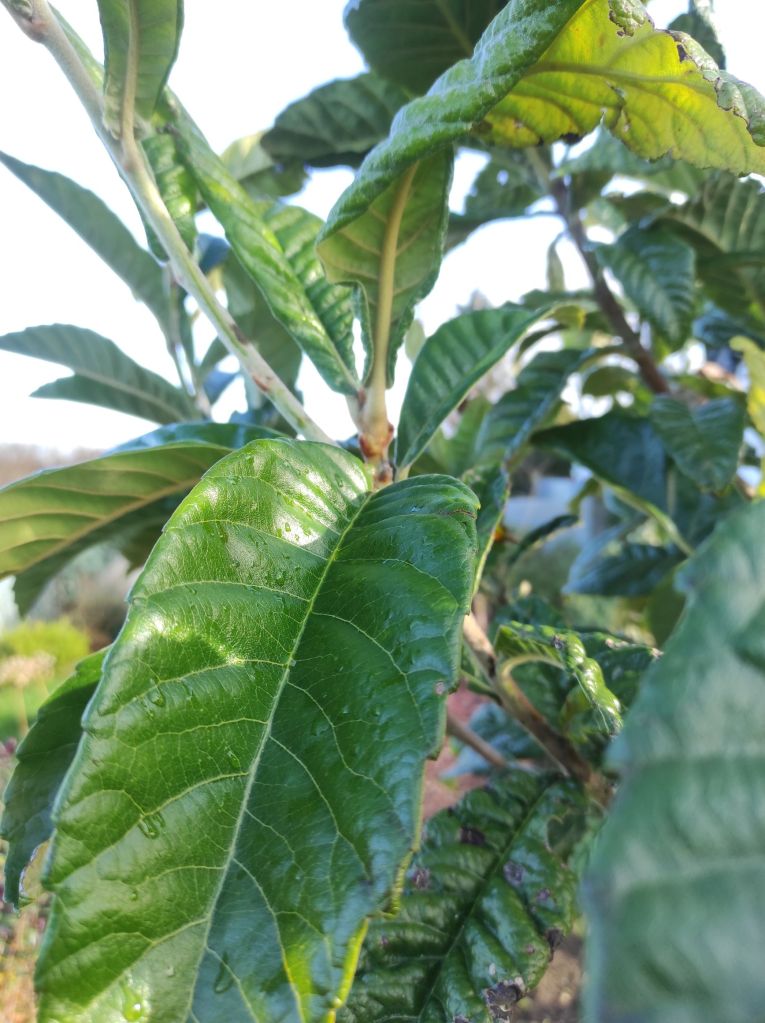
Loquat
Big green leafy loquat
Plant Profile: Eriobotrya japonica
This is a big shrub that with pruning can be maintained to a smaller size specimen, I have trained mine as a standard, on a stem, and I love it’s big evergreen leaves.



1. Common Name: Loquat
2. Scientific Name: Eriobotrya japonica
3. Family: Rosaceae
4. Plant Type: Evergreen tree
5. Native Range: China and Japan
6. Zone Adaptability: USDA hardiness zones 8-11; RHS hardiness ratings H4-H5
7. Ideal Conditions: Loquats thrive in full sun to partial shade and prefer well-drained soil. They can tolerate a range of soil types but prefer slightly acidic soil. They require regular watering, especially during dry periods.
8. Size: Loquat trees can reach a height of 20-30 feet (6-9 meters) and have a spread of 15-20 feet (4.5-6 meters).
9. Growth Rate: Loquats have a moderate growth rate.
10. Bloom Time: Late winter to early spring.
11. Bloom Description: Loquats produce small clusters of sweetly scented white flowers.
12. Leaf Description: The leaves of Eriobotrya japonica are large, glossy, and leathery, with a dark green color. They are lance-shaped with prominent veins.
13. Uses in Landscaping: Loquats can be used as ornamental trees in gardens and landscapes due to their attractive foliage, showy blooms, and edible fruit. They can be planted as a standalone specimen or used in mixed plantings.
14. Maintenance: Loquats require little care, pot grown specimens will need watering in summer, especially during dry periods. Pruning is recommended to maintain a desired shape and control the size of the tree. They are generally low-maintenance plants.
15. Pests/Diseases: Loquats are generally resistant to pests and diseases, but they can occasionally be affected by aphids, scales, or caterpillars. Proper cultural practices, such as providing good air circulation and avoiding excessive moisture, can help prevent most pest and disease issues.
16. Other Features: In addition to its attractive flowers and foliage, loquats produce small, juicy, and flavorful fruits that are edible when ripe. The fruits are yellow to orange in color and have a sweet and tangy taste. They need warm climates for fruit production, fruit is not often produced in Irish gardens, except in very warm summers and mild winters.
17. Propagating: Loquats can be propagated from seeds, cuttings, or by grafting. Seeds usually take several years to produce fruit, while vegetative propagation methods can produce fruiting trees more quickly.
18. Availability: Loquats are sometimes available at nurseries and garden centers, they tend to be offered as specimens trained in a stem.
19. Pollinators: The flowers of Eriobotrya japonica are pollinated by bees and other insects.
Eriobotrya japonica at The Paddock

.
The story of my plant starts at a farmers’ market in Boyle in Co. Roscommon about 10-12 years ago. I bought the delicious fruit there, it was the first time that I had seen the fruit for sale and the first time that I had the chance to taste them.
So, I saved the seeds and a number of plants germinated. The one that grows here in The Patio Garden I trained as a standard, it has moved with me in a pot for a decade until it got a chance to put down roots here at The Paddock.
I find it to be an easy plant to grow, it may show leaf damage after a harsh winter, but comes back well. Most years it is fine.
It tends look better in more sheltered situations, in a windy location the leaf edges will become a bit tattered looking.
I love the big leaves, they look quite exotic. It has grown reasonably fast and I plan on doing some pruning this year, maybe removing some lower branches to raise the crown, and then tipping back leading shoots to limit the size and encourage a bushier habit.
